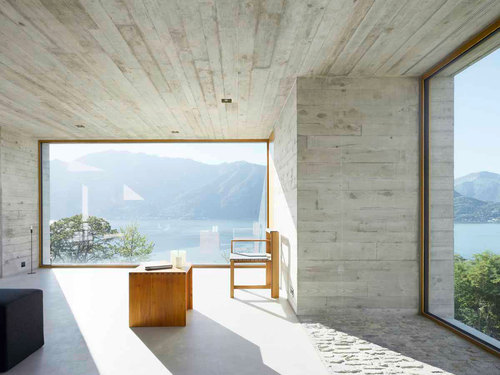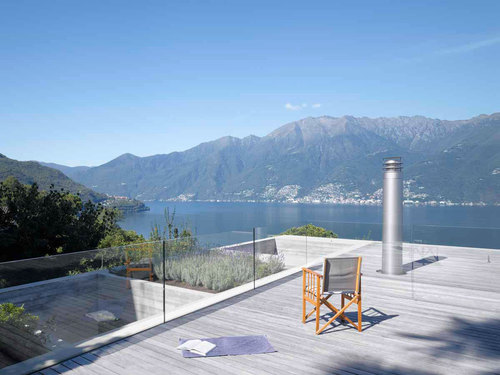In the town centre, close to the Place d’Armes, the town of Gournay-en-Bray has just completed a cultural centre which houses a multimedia library and cultural activities. This new centre is built on the site formerly occupied by the Damau factory. The “Workshop” (a reference to the old Damau factory workshops) meets two major challenges:
- building a contemporary structure at the back of the plot by redefining the relationship with its natural environment (gardens, alleys, neighbouring stone walls) and surrounding structures (noble styles, traditional shelters, buildings with character)
- ensuring the new structure is readable in relation to existing buildings by framing the views from the main and secondary entrances.
![L-atelier_039_large]()
© Luc Boegly . Published on September 05, 2013.
The Signal Building
With its gables echoing the outline of the existing lodge, the building known as “Signal”,
can be recognized by its copper grid cladding. A vertical, eight letter sign (4 metres high) made from PMMA (transparent thermoplastic) has been fitted 4.5 metres from the ground to identify the centre. To ensure it is readable with the semi-transparent grid behind it, the sign is backlit, letting off a soft, unobtrusive light.
The main function of this “open air” building is to announce the cultural centre on the high street. As the building has no commercial uses, the sign serves solely to communicate the town of Gournay- en-Bray’s cultural activities. The lettering reflects a contemporary re-reading of signs, a nod to the remarkable style of the advertising panels which, in the past, were so characteristic of rural French landscapes.
This building will mainly be used for administrative purposes and is not open to the public. The new EDF transformer substation is located inside the building, with technical platforms providing intermittent displays.
![L_atelier_017_large]()
© Luc Boegly . Published on September 05, 2013.
Spaces for cultural activities
The new building – the cornerstone of the project and the face of the cultural hub within – is in perfect harmony with the architecture of the town centre. The double sloping lines of the structures of yesteryear meet a contemporary archetype, dressed in dark purple slate and interrupted intermittently, depending on the needs of the programme, by volumes framing the landscape.
This type of plane, highly characteristic of the town of Gournay-en-Bray, becomes a thread linking old and new, a free reinterpretation, and a statement in favour of craft and style. The building includes a ground floor (multimedia library and dance school), a partial first floor (music school) and a partial basement (technical premises) which can be accessed from the outside.
![L_atelier_037_large]()
© Luc Boegly . Published on September 05, 2013.
With its views onto the garden, it is the only building open to the public. Designed as an H in the centre of the plot, it links the two main bodies in the centre. The body of the Maison des Associations (Local Clubs and Activities Centre) is an extension of the existing structure which lends its truss as a point of connection. The glass-panelled hall presents a generous space for exhibitions. It also serves as a “gateway”, to oversee access to various activities.
![Gournay_067_large]()
© Luc Boegly . Published on September 05, 2013.
The multimedia library
Is organized around a journey through life. The adult area is close to the entrance and the deeper visitors venture into the building the closer they get to the children’s areas. The woodwork suggests almost cathedral-like volumes, with a soothing light flooding the reading rooms.
![L_atelier_025_large]()
© Luc Boegly . Published on September 05, 2013.
The garden
The sloping gardens around the buildings, present simple “prairie-style” areas of wild grass, where South American dry prairie flowers nestle amongst a lower level of perennial plants. The patio garden at the heart of the Maison des Associations and multimedia library has been designed as a gardening space, a “garden of cutting flowers.” Tended to by the clubs or by external contractors, this space will be a free patchwork of succulent plants, high stems, flowers, clumps, and medicinal plants and will be managed like a prairie: a soft touch with occasional cuts.
The old orchard has been preserved. Next to the existing cherry trees, birches give additional depth to the landscape.
![L-atelier_020_large]()
© Luc Boegly . Published on September 05, 2013.
The music rooms
The first floor is entirely given over to teaching music. The teaching rooms have been designed around an inner passageway, with an urban feel.
![L_atelier_021_large]()
© Luc Boegly . Published on September 05, 2013.
The dance school.
Is located at the end of the left wing, in its corner. It settles into the main building with delicacy and elegance. The same architectural language as the main building or the signal building is preserved, that is to say, a deep purple slate covering and cladding, metal grid shutters and wide windows, referencing the building’s wide prows. These openings in the facade and roof ensures the dance rooms remain well-lit while protecting them from outside eyes.
![Gournay_014_large]()
© Luc Boegly . Published on September 05, 2013.
Dark purple slate
A homogenous material and a natural stone has been suggested for the cladding of the archetypes: dark purple slate from Canada. This is implemented in a traditional manner by the local crafts and trades guild. Its use is often reserved to prestigious buildings, but here it is implemented in streamlined design, masking the gutters, with no overhang on the roof. The whole (facades and roof) creates strong visual continuity. The envelope of scales created by the slates and the reflections of the schist, make the dark purple hue more vegetable than mineral. Thus, the poetry of the gardens and courtyards of the old Damau factory is preserved.
![Gournay_017_large]()
© Luc Boegly . Published on September 05, 2013.
The copper grid
The extensive glass facades are covered, in places, by a copper grid to dress the large volumes and transparent bays, creating intimacy or protection from the sun. This grid appears intermittently on the ground floor and extends over the entire height of the South truss to shield the large meeting room from outside eyes. Furthermore, it enters into conversation with the sign-building at the entrance. The diamond shaped corners of the copper boxes lend them a hard edge which brings them to life. The external gates are made from solid copper.
![L_atelier_010_large]()
© Luc Boegly . Published on September 05, 2013.
Larch
The “protruding boxes” which house the reading rooms, the children’s library and the storytelling corner are made from a larch cladding of varying thickness. The wide openings are fitted with external textile blinds to protect them from the sun.
Program: Spaces for cultural activities: multimedia library, music and dance school
Surface: 2 545 m2 SHON
7 700 m2 ground area
Cost of work: 5 790 000 € HT
Schedule: opening: july 2013
competition: december 2006
![L-atelier_041_large]()
© Luc Boegly . Published on September 05, 2013.
![L_atelier_048_large]()
© Luc Boegly . Published on September 05, 2013.
![Gournay_035_large]()
© Luc Boegly . Published on September 05, 2013.
![Gournay_037_large]()
© Luc Boegly . Published on September 05, 2013.
![Gournay_057_large]()
© Luc Boegly . Published on September 05, 2013.
![Resille__2__large]()
© Luc Boegly . Published on September 05, 2013.
![Resille__5__large]()
© Luc Boegly . Published on September 05, 2013.
![Resille__3__large]()
© Luc Boegly . Published on September 05, 2013.
![Gournay_063_large]()
© Luc Boegly . Published on September 05, 2013.
![Gournay_065_large]()
© Luc Boegly . Published on September 05, 2013.
![L-atelier_002_large]()
© Luc Boegly . Published on September 05, 2013.
![L-atelier_049_large]()
© Luc Boegly . Published on September 05, 2013.
![Hall__3__large]()
© Luc Boegly . Published on September 05, 2013.
![Est_2_large]()
© aavp architecture . Published on September 05, 2013.
![Est_4_large]()
© aavp architecture . Published on September 05, 2013.
![Ouest_2_large]()
© aavp architecture . Published on September 05, 2013.
![Nord_large]()
© aavp architecture . Published on September 05, 2013.
![Sud_large]()
© aavp architecture . Published on September 05, 2013.
![Pc5]()
© aavp architecture . Published on September 05, 2013.
![Plan_r_1____large]()
© aavp architecture . Published on September 05, 2013.
![Plan_rdc____large]()
© aavp architecture . Published on September 05, 2013.
![Plan_simple_large]()
© aavp architecture . Published on September 05, 2013.












































































































































































































































































































































































